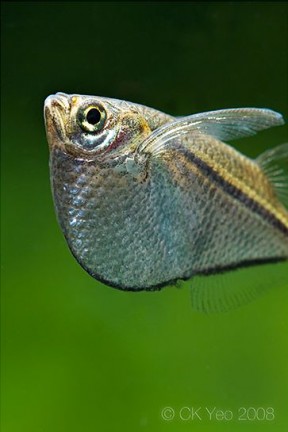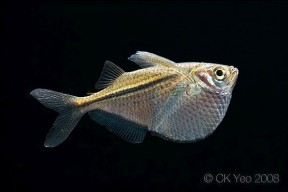Gasteropelecus sternicla
Common Hatchetfish, Silver Hatchetfish
SynonymsTop ↑
Clupea sternicla Linnaeus, 1758; Salmo gasteropelecus Pallas, 1770; Gasteropelecus argenteus Lacepede, 1803; Gasteropelecus coronatus Allen, 1942; Gasteropelecus sternicula marowini Hoedeman, 1952; Gasteropelecus sternicla morae Hoedeman, 1952
Etymology
Gasteropelecus: Greek gaster [= stomach] and pelecus [=hatchet, axe]
sternicla: Latin for breast, referring to the deeply extended thorax.
Classification
Order: Characiformes Family: Gasteropelecidae
Distribution
This species has a questionable distribution having been recorded from the middle Amazon basin in Peru and Brazil, plus rivers of Venezuela, Guyana, and French Guiana. It has also been collected in the Río Paraguay basin (Britski, et al. 2007).
Type locality is given simply as ‘Suriname’.
Habitat
Slow-moving forest streams, tributaries and swamps. The fish are most often found in areas with an abundance of surface vegetation.
Maximum Standard Length
35 – 40 mm.
Aquarium SizeTop ↑
An aquarium with a surface area measuring a minimum of 120 ∗ 30 cm or equivalent is required.
Maintenance
Cover a good portion of the water surface with floating plants, which will help to make this flighty species less skittish. Other décor is not particularly critical, but it looks good in both heavily planted set-ups and Amazon biotope-style tanks, with driftwood branches, a sand substrate and some leaf litter. Make sure the tank cover is very tightly fitting, as it is capable of clearing several metres in a single jump.
Unlike the species in Carnegiella, this hatchetfish will descend from the surface more often, to interact with conspecifics, feed, or simply remain motionless.
Water Conditions
Temperature: 20 – 28 °C
pH: 5.0 – 7.5
Hardness: 18 – 215 ppm
Diet
Naturally feeds on insects on and probably above the surface, crustaceans, worms. A study carried out on Thoracocharax stellatus (Netto-Ferreira et al, 2007) determined that 99.6% of the diet consisted of insects, and the majority (87.6%) of these were terrestrial.
Sometimes a little reluctant to take dried foods initially, but it will usually learn to accept them over time. A large proportion of the diet should consist of frozen and live foods, such as bloodworm and Daphnia. Gut-loaded Drosophila fruit flies make an excellent food if available.
Behaviour and CompatibilityTop ↑
Very peaceful but it can be nervous and shy, and will not compete well with boisterous species for food. Good tankmates include other small fishes that inhabit different parts of the tank, for example tetras and dwarf cichlids, or catfishes such as Corydoras and smaller Loricariids. Always buy at least half a dozen, as it will not settle without the security of conspecifics.
Sexual Dimorphism
Females are noticeably rounder-bodied than males when full of eggs.
Reproduction
Unknown. Probably breeds in a similar fashion to the marbled hatchetfish, Carnegiella strigata.
NotesTop ↑
This species spends almost all of its time at or just below the water surface, although it will sometimes retreat into midwater if threatened or feeding. Like other freshwater hatchetfishes, it is renowned for its ability to leap from the water surface and glide for distances of several metres. This behaviour is used both to catch flying insects, and to escape potential predators.
The family Gasteropelecidae is separated from other Characiformes by the following combination of characters: frontal bone longitudinally corrugated with a strong longitudinal ridge; posttemporal and supracleithrum fused into a single bone; pelvic fins and associated bones minute; presence of an enlarged, strongly convex muscular pectoral girdle region, consisting of greatly expanded coracoids fused to a single fan-shaped and corrugated median bone; lateral line extending ventro-posteriorly to approach the anal-fin insertion; 0-2 or 3 scales behind head and one or very few scales on caudal-fin base; 10-17 dorsal-fin rays; 22-44 anal-fin rays; adipose-fin present in larger species (those in Gasteropelecus and Thoracocharax), absent in smaller species (those in Carnegiella).
The family Gasteropelecidae contains three genera. Thoracocharax, the most primitive and distinguished by its impressive keel, contains two species, T. securis and T. stellatus. Gasteropelecus contains three species,G. sternicla, G. levis and G. maculatus. These two genera contain the largest in size of the hatchetfish, and all are silver in colouration; G. sternicla is the more frequently seen of these five species, though any of them may be offered as “Silver Hatchetfish.” The third genus, Carnegiella, contains four described species that are the most derived or specialized of the hatchetfishes, and all are smaller and lack an adipose fin.
Gasteropelecids are commonly-referred to as ‘freshwater hatchetfishes’ due to their heavily-keeled body shape which has evolved in such a way due to possessing an enlarged, heavily-muscled pectoral girdle, and which resembles the shape of a hatchet head.
They are sometimes said to be capable of propelled flight above the water surface by beating their pectoral fins but in fact this is not the case and was disproven by Wiest (1995) who used high speed video photography to demonstrate that the pectoral fins are used in leaving the water but not while the fish is in the air. The action is more accurately described as a powerful jump and is actually a modified threat response which only appears to be used in extreme circumstances much like in many other fishes.
The researcher also found that the fish only seem to be able to jump once or twice before requiring a rest period due to the large amount of energy required to work the massive pectoral girdle muscles, and when fatigued their threat response is comparable to that of other small species in that they dive towards the substrate.
In addition anecdotal evidence from fish collectors and icthyologists working in the field would suggest that gasteropelecids rarely jump and they also tend not to do so in aquaria, even when being chased with a net (pers. obv.). However, leaving the tank cover open during darkness is likely to result in one or more hatchetfish on the floor by morning, so clearly they can and will jump.
G. sternicla is generally considered to be the hardiest hatchetfish available in the hobby, but it can still be quite delicate when initially imported. Once acclimatised, it proves to be a very good aquarium resident. It is often confused with the silver hatchet, G. levis, and is often labelled as such when on sale.
Characiformes is among the most diverse orders of freshwater fishes currently including close to 2000 valid species distributed among 19 families. This tremendous taxonomical and morphological diversity has historically impaired the ability of researchers to resolve their genetic relationships with many genera remaining incertae sedis. A further limiting factor has been that in many cases exhaustive study of these on an individual basis is the only way to resolve such problems. Modern molecular phylogenetic techniques have allowed some headway, though, and research papers by Javonillo et al. and Oliveira et al., published in 2010 and 2011, respectively, revealed some interesting hypotheses.
The results of the former suggest that Gasteropelecidae forms a monophyletic clade nested within the family Characidae, while the latter expanded on this and concluded that within the family Carnegiella is the sister group of Gasteropelecus with Thoracocharax sister to that clade, and that Gasteropelecidae appears most closely-related to the authors’ expanded Bryconidae which contains the genera Brycon, Henochilus and Salminus.
Others such as Oliveira et al. (2011) have concluded that the family Erythrinidae is also closely-related to this grouping with Hepsetidae and Alestidae more distant.
References
- Linnaeus, C., 1758 - Holmiae. v. 1: i-ii + 1-824
Systema Naturae, Ed. X. (Systema naturae per regna tria naturae, secundum classes, ordines, genera, species, cum characteribus, differentiis, synonymis, locis. Tomus I. Editio decima, reformata.). - Britski, H.A., K.Z. de Sz. de Silimon and B.S. Lopes, 2007 - Brasília, DF: Embrapa Informaçäo Tecnológica: 227p
Peixes do Pantanal: manual de identificaçäo, 2 ed. - Javonillo, R., L. R. Malabarba, S. H. Weitzman and J. R. Burns, 2010 - Molecular Phylogenetics and Evolution 54(2): 498-511
Relationships among major lineages of characid fishes (Teleostei: Ostariophysi: Characiformes), based on molecular sequence data - Netto-Ferreira, Andre L., Miriam P. Albrecht, JorgeL. Nessimian and Erica P. Caramaschi , 2007 - Neotropical Ichthyology 5(1): 69-74
Feeding Habits of Thoracocharax stellatus (Characiformes: Gasteropelecidae) in the upper Rio Tocantins, Brazil - Oliveira, O., G. S Avelino, K. T. Abe, T. C Mariguela, R.C Benine, G. Ortí, R. P. Vari and R. M. Corrêa e Castro, 2011 - BMC Evolutionary Biology 11: 275-300
Phylogenetic relationships within the speciose family Characidae (Teleostei: Ostariophysi: Characiformes) based on multilocus analysis and extensive ingroup sampling - Silva, Edson Lourenco da, Rafael Splendore de Borba, Liano Centofante, Carlos Suetoshi Miyazawa, and Patricia Pasquali Parise-Maltempi, 2012 - Comparative Cytogenetics 6(3): 323-333
Cytogenetic analysis in Thoracocharax stellatus (Kner, 1858) (Characiformes, Gasteropelecidae) from Paraguay River Basin, Mato Grosso, Brazil - Weitzman, Stanley H. and Lisa Palmer, 1996 - Tropical Fish Hobbyist, September 1996: 195-206
Do Freshwater Hatchetfishes Really Fly - Wiest, F.C., 1995 - Journal of Zoology 236 (4): 571-592
The specialized locomotory apparatus of the freshwater hatchetfish family Gasteropelecidae




